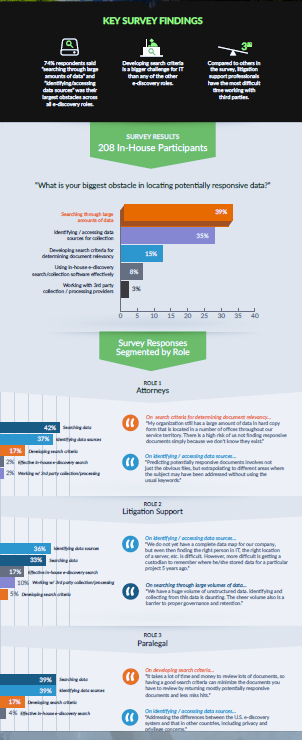Consider Alternatives to Releasing a Public Report
No law firm, department, or vendor leaks its internal survey to the outside world. Of course not. But here the focus instead is on external surveys. Most sponsors take pains to prepare a handsome PDF report. Then they allow – actively encourage, in fact – anyone to download it from their website, often after the downloader provides contact information. Additionally, sponsors e-mail the report to all their survey’s respondents. But those paths are not the only ones; here are seven other ways to release a survey’s findings to the public.
Infographic: Every now and then a sponsor prepares an infographic that summarizes the key discoveries from the survey. An infographic takes time and effort to prepare, but it takes less of each than a full-scale report. Below is an illustrative image of an infographic about e-discovery produced by Exterro’s survey in 2015.

Reporter’s article: Sometimes the sponsor shares the results of a survey with a publication, and one of its reporters writes an article, or a series of articles, around the findings. Articles may include quotes by senior lawyers or executives of the sponsor that serve as expert commentary on the findings.
Internet release: Other sponsors spoon out their survey findings on their blog. They might publish several pieces or one large document. They typically include a plot or two. I recently read about a survey where the sponsor explained that the results would be available only on its website.
Thought piece: Also known as a “white paper,” it could be the chosen vehicle for releasing figures and commenting on them extensively. The piece is usually much longer, more text intensive, and cites related research. It aims for deeper thought, sophisticated analyses, and more extended interpretations of the survey data.
Paper version: As I have mentioned, survey results might only be unveiled and distributed in hard copy at a conference. Everyone has seen copies of old-fashioned, printed material left on the seats or in the packages of attendees.
More methods: Other alternatives to release findings include YouTube posts or podcasts. These methods of distribution are unusual. Using a self-publishing platform such as Leanpub, it would be possible to send findings to everyone who visits the platform or learns about it because they participated in the survey. By that capability, they could get periodic updates, such as a cumulative report. I am not aware of anyone implementing this idea.
Without doubt, an energetic sponsor might not only produce the polished PDF report but also take advantage of any of these methods to distribute results. Each has arguments for them and arguments against them.